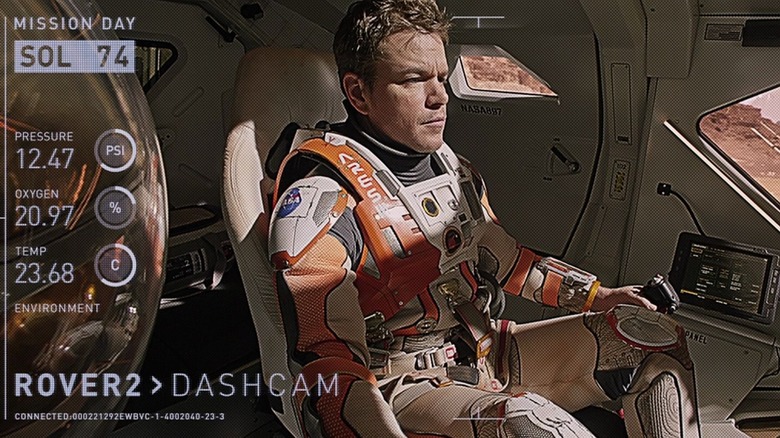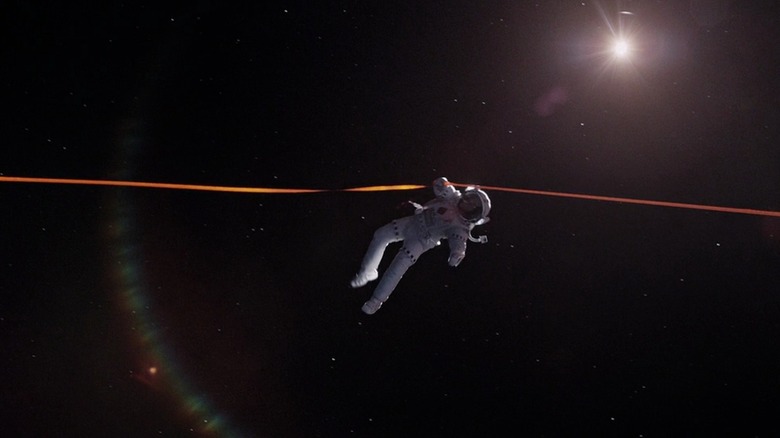
In Ridley Scott’s “The Martian,” the crew of the Ares III head to Mars for an expedition. Simply as their ascent automobile lands, a extreme mud storm topples it, inflicting the crew to scramble towards their orbiting vessel. Nevertheless, one crew member, Mark Watney (Matt Damon) will get hit by particles and is left behind, presumed lifeless. What ensues is Mark’s tireless makes an attempt to determine communication with NASA, whereas attempting to science the heck out of this example to remain alive. A wise steadiness is struck between remaining scientifically genuine and making these high-concept concepts accessible, as Mark’s perseverance solely bears fruit due to his data as a botanist and mechanical engineer. However how scientifically correct is “The Martian?”
To reply this query shortly: it’s fairly correct. NASA’s Jet Propulsion Laboratory (JPL) helped flesh out the scientific particulars of the story, with real-life Mars exploration knowledge getting used to map the onscreen planet’s terrain and design suitable autos. The Mars Pathfinder, which Mark makes use of to outlive and talk, was constructed and designed by JPL to grant legitimacy to the technical points of this survival story. Even among the gadgets used listed here are actual, together with the RTG (which works like a battery) Mark makes use of to remain heat, as related energy methods are nonetheless used for Mars-related missions.
That mentioned, there are many inaccuracies right here and there. This doesn’t essentially detract from the expertise, because the “fiction” a part of science-fiction additionally must do some heavy lifting to raise essentially the most grounded premises. “The Martian” succeeds in doing so, because it re-frames a perseverance story into one which dares to defy expectations. There may be humor blended in with pathos, and timeless hope laces Mark’s lengthy, arduous journey again to Earth. On that observe, let’s take a look at what the movie will get proper and unsuitable concerning the science concerned from begin to end.
The Martian will get some geographical details about Mars unsuitable
The mud storm is the catalyst for the occasions of the movie, however is it a pure occasion that may happen on Mars? Effectively, the crimson planet’s ambiance is way thinner than the Earth’s, which implies that a powerful wind (like one at 100 mph) would really feel a lot much less potent (round 10-11 mph). If the strongest gust of wind on Mars just isn’t highly effective sufficient to knock down a human being, it can’t topple a heavy Mars Ascent Car (MAV). Nevertheless, the mud storm is a good fictional catalyst that triggers Mark’s survival story in area.
Subsequent, Mark synthesizes drinkable water from rocket gasoline by dissociating (splitting the molecules to kind different states of matter) it into nitrogen and hydrogen. He takes the hydrogen and burns it utilizing the oxygen contained in the cabin to make water. This isn’t inaccurate, as it will work 100%, however an individual stranded on Mars has a greater, faster method to synthesize water. You see, water is considerable on Mars within the type of ice and permafrost, so the planet’s soil is a wealthy reservoir that can be utilized shortly for this objective. However after all, dissociating rocket gasoline is a reasonably cool factor to do (though one misstep can break all of the progress).
Now, let’s speak about gravity. Mars has one-third of the gravity we expertise on Earth, which makes people and objects weigh a lot lower than what they do again on Earth. For instance, if a rock weighs 100 kilograms on Earth, it’ll weigh round 33 kilograms (and therefore really feel a lot lighter) on Mars. In “The Martian,” this isn’t factored in in any respect, as all of the astronauts appear to be exhausted after climbing ladders or strolling round of their astronaut gear. Though the gear is fairly heavy on Earth, it should not encumber motion on Mars, as lesser gravity will warrant lesser exertion.
Is the slingshot methodology in The Martian scientifically believable?
When all efforts to rescue Mark appear borderline not possible, JPL astrodynamicist Wealthy Purnell (Donald Glover) proposes a dangerous, ballsy plan. He means that the re-supply launcher ought to rendezvous with the unique spacecraft, The Hermes (the place Mark’s crew are at that second), which is able to then use Earth’s gravity to slingshot again to Mars. Despite the fact that a number of issues go horribly unsuitable, The Hermes crew succeeds in rescuing Mark after he punctures his strain swimsuit to propel himself towards Commander Lewis (Jessica Chastain). This makes for an exciting, high-stakes cinematic climax, however is it virtually possible in any respect?
Sure, it’s! In actual fact, it is a real-life methodology that’s used to speed up the pace of a spacecraft or redirect its path to save lots of propellant or cut back prices. Generally known as a gravity help, this maneuver makes use of relative motion (trajectory of a planet’s orbit across the solar) and planetary gravity to simulate a slingshot impact just like the one proven within the movie. Though this methodology was first used throughout a Soviet probe of Luna 3, Michael Minovitch (who labored as a trajectory analyst at JPL) developed a gravity help method in 1961, which helped improve spacecraft velocity down the road. This know-how ultimately grew to become the inspiration for the groundbreaking Voyager area missions.
Smaller particulars about “The Martian,” just like the time taken to journey to Mars — which is shut to eight months — are additionally correct. Even the science behind Mark having the ability to develop potatoes on Martian soil is scientifically sound, as it’s potential to nurture vegetation with the planet’s soil, however that additionally depends upon the standard of the chemical and mineral content material. Let’s simply assume that Mark acquired fortunate in some points, however each different survival milestone he achieves is totally to his credit score. The remainder can merely be chalked as much as the enduring energy of cinema.



